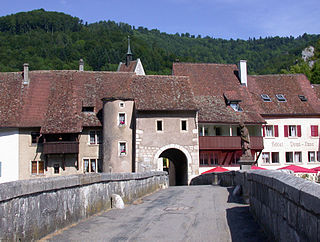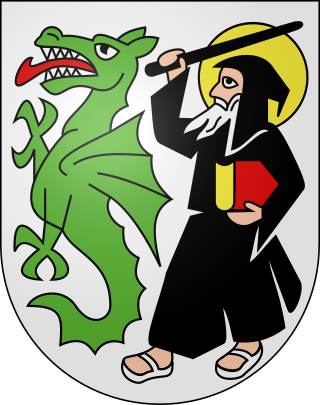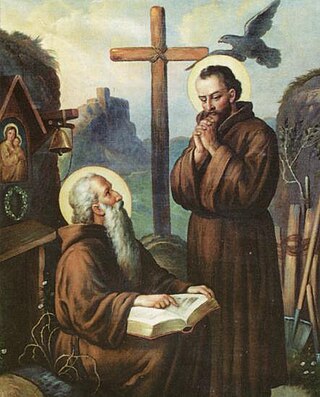
A hermit, also known as an eremite or solitary, is a person who lives in seclusion. Eremitism plays a role in a variety of religions.

Saint-Ursanne is an old town and a former municipality of the district of Porrentruy in the canton of Jura, Switzerland which has preserved much of its medieval character. The town contains many historical buildings, including a Romanesque abbey church, a collegiate church, a cloister, many medieval houses, a hermitage and an 18th-century bridge. The river Doubs makes a loop near Saint-Ursanne before flowing into France. Since 2009 Saint-Ursanne has been a part of the new municipality Clos du Doubs. An active railway station is located above the town, to the east.

The Doubs is a 453-kilometre (281 mi) river in far eastern France which strays into western Switzerland. It is a left-bank tributary of the Saône. It rises near Mouthe in the western Jura mountains, at 946 metres (3,104 ft) and its mouth is at Verdun-sur-le-Doubs, a village and commune in Saône-et-Loire at about 175 m (574 ft) above sea level. It is the tenth-longest river in France.

Col de la Croix is a pass in the Jura range connecting Saint-Ursanne and Courgenay, both in the canton of Jura in Switzerland.

Saint-Claude is a commune and a sous-préfecture of the Jura department in the Bourgogne-Franche-Comté region in eastern France. It lies on the river Bienne.
Saint Ursicinus may refer to:
Ursicinus of Ravenna is venerated as a martyr by the Catholic Church. He was said to be a physician of Ravenna. His legend is connected with that of Vitalis, who is said to have encouraged the wavering Ursicinus after the physician was sentenced to death for his faith. After he was beheaded, Vitalis buried him in Ravenna.
Imerius of Immertal was a monk, hermit, and missionary in the present Swiss Jura. The name of the town of Saint-Imier refers to him.

Beatus of Lungern, known also by the honorificApostle of Switzerland or as Beatus of Beatenberg or Beatus of Thun, was probably a legendary monk and hermit of early Christianity, and is revered as a saint. Though his legend states that he died in the 2nd century, it is likely that his story has been conflated with other saints of the same name, especially Beatus of Vendôme, and an Abbot Beatus who received a charter in 810 from Charlemagne to confirm that Honau Abbey would be administered by Irish monks.

Saint Germanus of Granfelden was the first abbot of Moutier-Grandval Abbey. He is venerated as a martyr saint in the Catholic and Eastern Orthodox Churches.
Romanus of Condat is a saint of the fifth century. At the age of thirty five, he decided to live as a hermit in the area of Condat. His younger brother Lupicinus followed him there. They became leaders of a community of monks that included Eugendus.
Ursicinus of Brescia was an Italian saint, and bishop of Brescia in Lombardy. He participated in the council of Sardica in 347, in which year he died; his shrine may still be seen. His feast day is 1 December.

Saint Wandregisel was a Frankish courtier, monk, and abbot.
Saint-Lyé-la-Forêt is a commune in the Loiret department in north-central France.

Clos du Doubs is a municipality in the district of Porrentruy in the canton of Jura in Switzerland. It was founded on January 1, 2009 by the former municipalities of Epauvillers, Epiquerez, Montenol, Montmelon, Ocourt, Saint-Ursanne and Seleute. Soubey voted not to join the merger.

Ursicinus is a saint of the Catholic Church and was Bishop of Ravenna from 533 to 536. He is not to be confused with the 1st-century saint Ursicinus of Ravenna.

Benedict of Skalka or Szkalka, born Stojislav in Nitra, Hungarian Kingdom, was a Benedictine monk, now venerated as a saint. He became a hermit and lived an austere life in a cave along the Vah River. Benedict was strangled to death in 1012 by a gang of robbers looking for treasure. He is venerated in Slovakia, Hungary, Poland and the emigrant diasporas in the United States.

December 19 - Eastern Orthodox liturgical calendar - December 21
Eadwold of Cerne, also known as Eadwold of East Anglia, was a 9th-century hermit, East Anglian prince and patron saint of Cerne, Dorset, who lived as a hermit on a hill about four miles from Cerne. His feast day is 29 August.

St-Ursanne railway station is a railway station in the former municipality of Saint-Ursanne, now part of Clos du Doubs, in the Swiss canton of Jura. It is an intermediate stop on the standard gauge Delémont–Delle line of Swiss Federal Railways.













